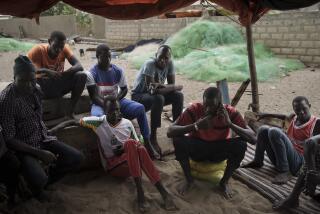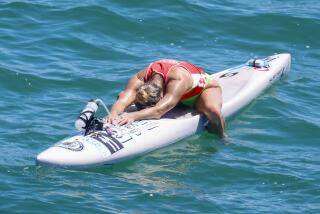Uncharted waters
- Share via
CAPE TOWN, SOUTH AFRICA — At first, there was a naive purity about Africa’s first America’s Cup challenge, South Africa’s Team Shosholoza. The sailors were South African, their vessel was a second-hand tub and instead of any talk of bringing the Cup to Africa, they talked idealistically about bringing a piece of Africa to the Cup.
The multiracial team, with crewmen from dusty black townships where most people had never even seen the sea, sent out an inspiring message that some things were more important than winning: Team Shosholoza puts an end to America’s Cup yacht racing as a white man’s sport.
Then one day an idea crept in: What about actually trying to win?
For 132 years, the America’s Cup stayed in the New York Yacht Club. Even after 1956, when the requirement that other nations’ challengers had to sail their boats to the U.S. to compete was removed -- something critics had said made it almost impossible to win -- it was 27 years before Australia unbolted the Cup and took it home in 1983, with a small golden wrench that had been confidently fashioned in advance for the task.
Even today, the notion of the “Auld Mug” going to Africa would be a similar extraordinary victory. “The idea from the beginning was to show South Africa to the world. Now maybe I am making a big mistake, because I am starting to dream about winning the America’s Cup,” Salvatore Sarno, the team’s managing director, said in a recent interview in Cape Town.
The problem was that if winning were the goal, the purity would have to go. So in August 2005, after some disappointing races, Sarno called a team meeting.
“I said, ‘What do you prefer: That we continue to be 100% South African and sit on the bottom? Or we bring in some good specialists and we start to win?’
“Everyone said, ‘We want to win.’ ”
The America’s Cup will be defended by champion Switzerland off Valencia, Spain, this year, with the New Zealand and American teams shaping up as the strongest challengers. Team Shosholoza hopes to change all that.
“Shosholoza” is a Zulu word meaning “Go forward,” from an old workers’ song, sung in mines during the apartheid era. It has come to symbolize grit and stubborn determination in the face of adversity.
Although Team Shosholoza’s publicity machine still boasts of the crew being “proudly South African” -- skipper Mark Sadler, a lifelong sailor, is a native South African -- and crew members still talk about proving the strength of South African design and technology, Team Shosholoza no longer symbolizes South Africa in quite the way originally intended.
In fact, it is more a symbol of how international crews have to be to compete. Team Shosholoza, with more than 10 nationalities, is now as international as most of the other teams, with two Italians, a German, an Englishman and an Australian in the crew. The team’s tactician for the end of the 2005 season and last season was a Californian, Dee Smith, now a consultant.
Its campaign yacht, Shosholoza RSA 83, with its Australian-built keel, was the product of a primarily British design team. The yacht was launched in 2005 to replace the team’s original vessel.
South Africa’s bid would not have come about if not for Sarno, a native Italian now living in Durban, who dreamed up the idea, pulled the team together and hunted down sponsors.
South African corporate sponsors shunned the team.
“The message of Shosholoza is that a lot of us with different cultures and different origins can work together and together we can win,” Sarno said.
The main sponsors are Europeans: T Systems, the business arm of Deutsche Telekom, and the Mediterranean Shipping Company (MSC), which has played nursemaid to the South African bid. Sarno is the South African chairman of the South African wing of MSC.
“All of us are very frustrated and very upset over the response from South African corporations,” Sarno said. “They don’t understand what the America’s Cup is. Somebody wrote to me to say that the America’s Cup is an elitist sport and they prefer not to give money for an elitist sport. But it’s a fantastic sport and we are racing against the best sailors in the world. People [in South African business] don’t realize that.”
Team Shosholoza came in seventh in last year’s races leading up to the Cup, a remarkable result for the newcomers. The team hopes that modifications to the vessel in recent months will make it more competitive in the challenge in Valencia.
And although Team Shosholoza was ignored by the corporate giants, it was flooded with little donations from ordinary South Africans.
“There have been hundreds and hundreds of small employees who have sent in donations,” Sarno said. “That boosts my morale because I say, ‘That old man sent me 500 rand [$68]. My message is received -- not by the corporate people, but it’s got through to ordinary people.’ ”
Sarno grew up as the son of working-class parents in Southern Italy in a small village with a view of the ocean. He became a commercial sea captain, but his passion is sailing.
Two of Shosholoza’s crew -- Golden Mgedeza, 25, a miner’s son, and Solomon Dipeere, 24, son of a boilermaker -- grew up in Kwa Thema, a township 50 miles east of Johannesburg built for black families. There was no ocean, and not much water either.
Ocean sailing was about as alien as flying in a spaceship.
But there was a local group of “naval cadets,” which spent most of its time practicing sailors’ knots and rowing a dinghy around a small muddy pond.
At 15, both won apprenticeships from a shipping company for marine studies at a high school near Cape Town.
Then, for the first time, Mgedeza had an appreciation of the sea, and its size. He was captivated by the beautiful yacht sails fluttering.
When the two had the chance to join a navy sailing program, they jumped at it.
The first time Mgedeza went out in a yacht, he got seasick, but he was determined not to miss a lifetime’s chance to be on the sea. He kept going back.
“I knew I could get over it. It didn’t stop me from sailing,” he said.
In the late 1990s, the two met renowned South African yachtsman Ian Ainslie through the sailing program, and he took a group to Durban, where they met Sarno.
They began sailing with him. Then one day he asked them and a group of other sailors to give up their jobs and join an America’s Cup bid.
Mgedeza was assailed with doubts.
“I was going up the ladder and now I had to give all that up,” he said. “It was a huge risk. I sat down and thought, ‘What am I giving up? And for what?’ It was just giving up all I’d achieved.”
In the end, Sarno’s passion won him over. Now, Mgedeza wants to use the experience of sailing an America’s Cup race to build a career as a full-time professional.
“It’s very important for us to be sailing there and to be putting out giant footsteps for the future of sailing in post-apartheid South Africa,” he said.
Dipeere sees the team as sending out a strong message that blacks can do anything in South Africa.
“For all apartheid, it was all white and no black. Now it’s the other way around and there’s not many [white] people who are happy about that,” he said. “The crew is made up of all different races, black guys, white guys and that’s one theme in the new South Africa: getting everyone to work together.”
Both are certain the team can take home the Cup this year.
“We’ll race very hard and we’ll win races,” Mgedeza said. “And then we’ll see.”
More to Read
Sign up for The Wild
We’ll help you find the best places to hike, bike and run, as well as the perfect silent spots for meditation and yoga.
You may occasionally receive promotional content from the Los Angeles Times.






